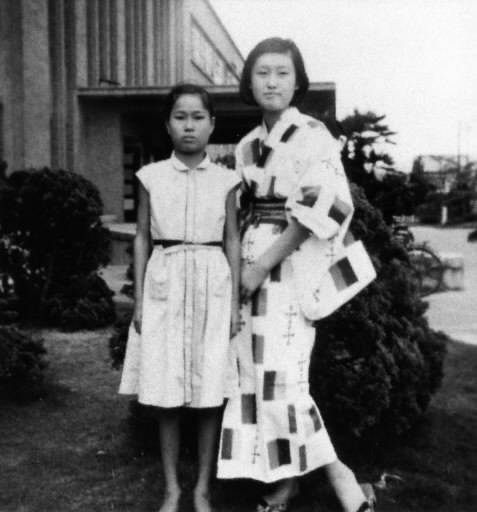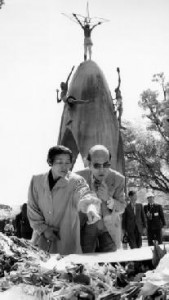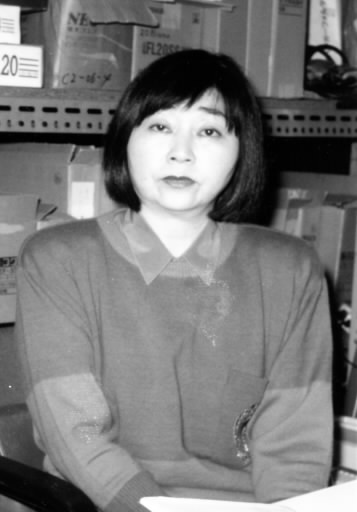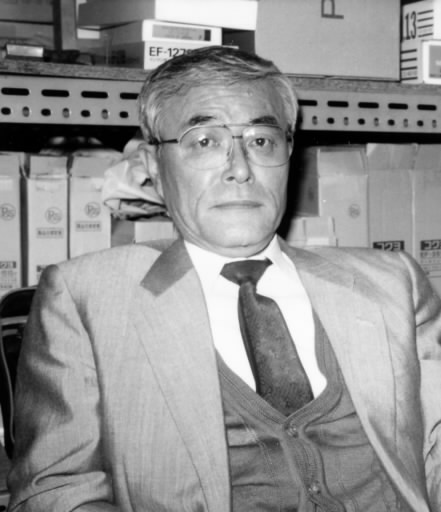History of Hiroshima: 1945-1995 (Part 14, Article 1)
Aug. 1, 2012
The Children’s Peace Monument
by Masami Nishimoto, Staff Writer
Note: This article was originally published in 1995.
The Children’s Peace Monument and the Memorial Cathedral for World Peace were both built in the 1950s when the city was on the road to reconstruction. These landmarks are symbols of the A-bombed city of Hiroshima and were raised to help console the spirits of the A-bomb victims and renew the call for peace.
The life of Sadako Sasaki, the girl who served as the inspiration for the Children’s Peace Monument, has been featured in a number of books and films. However, the stories told in these books and films have taken on a life of their own over the years. At the same time, the presence of Father Hugo Lassalle, the late German cleric who was the force behind the construction of the cathedral, is known to a shrinking circle of people that includes mostly the church community itself. The passage of 50 years since the atomic bombing has led to the growth of legends as well as the withering of other truths.
Through records and testimonies of those who knew these two directly, the Chugoku Shimbun has traced the lives of the girl who has become a symbol of peace and the priest who has been largely forgotten. This effort was motivated by our belief that, in order to help stem the myth-making associated with the atomic bombing and prevent the reality of Hiroshima’s experience from fading away, we have no choice but to dig up the facts that have been buried beneath the thick layers of time.
Sadako Sasaki dies after battling leukemia for 247 days
Standing 139 centimeters tall and weighing 31 kilograms, the girl, who had just turned 12, moved through the front doors of the Hiroshima Red Cross Hospital in February of 1955. The girl’s name was Sadako Sasaki, and she would pass away eight months later from leukemia.
The stories told about Sadako, the tales that have taken on a life of their own, are found even in the name of this hospital. And it isn’t simply the stories, but also some records which state that “Sadako died at the Hiroshima Atomic Bomb Hospital.” However, the Hiroshima Atomic Bomb Hospital opened in 1956, the year following Sadako’s death.
“Sadako was diagnosed with subacute lymphocytic leukemia by the Atomic Bomb Casualty Commission [ABCC] just prior to entering the Hiroshima Red Cross Hospital,” said Dr. Joji Numata, 73, as he leafed through a large notebook, its cover now a faded pale color from the passing years. Dr. Numata, who currently practices medicine in Asaminami Ward, was once Sadako’s doctor and then the deputy director of pediatrics at the Hiroshima Red Cross Hospital. On the cover of the notebook is written the word “Leukemia” in English. The notebook contains detailed records of the medical treatment he provided to the young leukemia patients under his care.
Sadako was first examined, and hospitalized, on “February 21.” She passed away in the hospital on “October 25.” Sadako’s short life had come to an end after battling the disease for 247 days. But until the last minute, when the flame of her life flickered out, she lived with all her might.
Sadako was exposed to the atomic bomb while at home in the Kusunoki district, about 1.6 kilometers from the hypocenter. Even now, it is often noted that she experienced the bombing in the Misasa district instead, probably because someone who even claimed to have attended her funeral wrote on a number of occasions that this was the location where she was exposed to the blast.
A tomboy, Sadako earned the nickname “monkey” in the sixth grade at Noboricho Elementary School, the last school she attended. She was able to best even the boys at vaulting over a pommel horse and was chosen to represent the class on a relay team. For a while her cheerful streak remained intact even after entering the hospital. It was not unusual for her to disappear from the children’s ward when it was time for their temperatures to be taken.
“She was running about in the hospital so much that I even wondered if she was really sick,” recalled Kiyo Okura, now 54. Ms. Okura, a resident of Tokyo, slept in the bed next to Sadako. She was suffering from tuberculosis at the time and had been in the children’s ward since the year before Sadako arrived at the hospital.
Sadako, who moved into the two-person room in May, called Ms. Okura, two years older, “Big Sister” and took to fawning over her. Ms. Okura was an only child who loved to read and found this bothersome at first.
But one incident revealed to Ms. Okura the fear hidden in Sadako’s heart.
On July 4, in a humid rainy season that had continued to linger, a five-year-old girl from their ward died. When the girls paid their respects at the hospital mortuary, Sadako quietly murmured, “Am I going to die like this, too?” Embracing Sadako’s thin shoulders, Ms. Okura could not stop crying.
Ms. Okura said, “I think she realized, in her heart, that her illness was serious. Maybe she thought it was connected to the atomic bombing...”
Ms. Okura was also exposed to the atomic bomb, experiencing the blast in the Minamikannon district. She did not speak with certainty regarding her perceptions of Sadako, since the age of the girls prevented them from speaking more directly about the bombing. But when she gathers up the fragments of memory from that time, she cannot help but reach the conclusion that the bomb was likely on Sadako’s mind.
At what point did Sadako become inspired to start folding paper cranes, the act that led to her fame? This part of her story, beginning with the idea that Sadako was moved to fold the cranes because she believed she could overcome the illness if she completed 1,000, is even described in a display at Hiroshima Peace Memorial Museum. With regard to this question, there are a number of speculations. But Ms. Okura said that Sadako’s initial motivation came in the form of cellophane cranes sent to the hospital at the end of July from a girls’ school in Nagoya.
On August 4, 1955, the year marking the tenth anniversary of the bombing, the Chugoku Shimbun ran an article with a large headline about folded cranes sent from Nagoya. At the time, giving folded cranes as gifts to people who were ill was not yet a common practice.
The members of the Junior Red Cross at Shukutoku High School in Nagoya had sent 4,000 cellophane cranes, in such colors as red, yellow, and purple, to the branch of the Japanese Red Cross Society in Hiroshima Prefecture along with a letter asking that the cranes be given to “patients suffering from A-bomb diseases.” Half of these cranes were then distributed at the Hiroshima Red Cross Hospital. Though Ms. Okura and Sadako shared the room, it seems somehow only Sadako received some cranes.
“They’re pretty. Shall we fold cranes, too?” Ms. Okura doesn’t recall which one of them suggested the idea, but the two girls soon began folding their own cranes.
The girls made the rounds of the hospital wards to collect the used wrapping paper from presents. Then they used scissors to cut the paper into five-centimeter squares and folded the paper into cranes. When they had a small pile of cranes, they strung them on a thread and hung them from a curtain rail. Initially, the cranes were just a way to pass the tedious hours of being in the hospital, but they quickly lost themselves in the activity. They became so engrossed in folding the cranes that a nurse would have to tell them, “It’s time for bed now.”
On the day before the anniversary of the atomic bombing, Sadako obtained permission to leave the hospital for one night. She enjoyed the chance to be with her family, which included her parents, who ran a barber shop in the Motomachi district, an older brother, a younger brother, and a younger sister.
Sadako’s father Shigeo, now 79, and her mother Fujiko, 76, had prepared themselves for the fact that their eldest daughter no longer had much time left. Still, they did what they could to pursue a course of treatment, scraping together funds from their modest lifestyle to pay for a blood transfusion to reduce Sadako’s fever and bleeding as well as anticancer drugs provided by the ABCC.
Sadako folded paper cranes as if in competition with Ms. Okura. That year the World Conference Against A- and H-Bombs was being held in Hiroshima and a song sung at the gathering, called “No A-bomb,” reached Sadako’s ears. She would sometimes hum the tune while folding her paper cranes.
In September, Ms. Okura returned home to recuperate. By that time, each girl had folded over 1,000 paper cranes and they celebrated their achievement. When Sadako’s story was first turned into a movie, people around Ms. Okura asked her about the paper cranes. Though she told them her account, her version was not believed.
Later, newspapers, too, would print versions like: “Sadako collapsed after folding 960 paper cranes.” Then, “records” appeared that began with the phrase “According to the testimony of Ms. Okura, the facts are...” and yet this information even contained errors in Ms. Okura’s name and the name of her school. In this way, one version of the story would lead to the next.
As the fall wore on, Sadako became increasingly frail. Her mother would go straight to her hospital room as soon as she finished her work at the barber shop. She slept with Sadako in her hospital bed almost every night. When Sadako’s mother combed her hair into braids, strands of hair would come out.
With Sadako continuing to fold paper cranes on her bed, her father told her, “You’ll get exhausted, pushing yourself like that.” But Sadako responded with determination in her voice: “I know, I know. I have a plan.” She then began folding very tiny paper cranes, using a needle to bend the small wings.
In mid-October, her temperature fluctuated wildly, rising and falling from a normal range to almost 40 degrees. The pain in her joints spread throughout her lower limbs. But she gritted her teeth and endured pain that would have made even an adult cry out. Finally, her head ached, too, and subcutaneous bleeding was observed.
On the morning of October 25, Fujiko, who had stayed the night with her daughter, called the family to Sadako’s bedside. The five members of the family gathered at the head of her bed.
At a loss, Sadako’s father could only manage to say to her: “Would you like some ochazuke [hot tea poured over rice]?” “Yes,” Sadako replied. Sadako’s father dipped into a bowl and fed her two spoonfuls of rice garnished with yellow bits of pickled radish. “It’s delicious,” Sadako said, and these words would be her last. She passed away at 9:57 a.m.
The results of the autopsy performed by ABCC doctors found that Sadako had also developed thyroid cancer.
After Sadako’s death, a sheet of coarse paper was discovered in her hospital room. The paper was Sadako’s “blood cell record” in which she had regularly written down her blood cell counts. Why did the 12-year-old girl come up with the idea of keeping such a record of her declining health? What did she feel as she faithfully wrote down these figures? Her record, which also captures Sadako’s silent cry, is now preserved in Hiroshima Peace Memorial Museum.
Sixth graders of Noboricho Elementary School inspire campaign to erect Children’s Peace Monument
“This is our cry. This is our prayer. For building peace in the world.” (Inscription on the Children’s Peace Monument)
On May 5, 1958, three years after Sadako Sasaki died, the Children’s Peace Monument was unveiled in Hiroshima Peace Memorial Park. To erect the memorial, donations amounting to roughly 5.8 million yen (interest on the contributions included) were collected through a fund-raising campaign by children throughout Japan. The effort was originally prompted by a call made by Sadako’s sixth-grade classmates of the “Bamboo” class at Noboricho Elementary School.
“We hated the atomic bomb, which took Sadako, an innocent girl, from us,” Nobuhiko Jigo said. “Our anger was the kind of pure anger that only a child can feel.” Mr. Jigo, now 52 and a resident of Naka Ward, led the “solidarity group,” comprised of students from the Bamboo class.
The children in the Bamboo class, including Sadako, had numbered 63. Almost half were exposed to the atomic bomb or lost parents in the war. Mr. Jigo, too, experienced the atomic bombing at a location 1.2 kilometers from the hypocenter. He took Sadako’s death very personally.
Tomiko Kawano (nee Yokota), also a resident of Naka Ward, was on the relay team with Sadako. “Once I entered junior high school, I paid fewer visits to Sadako in the hospital,” she explained. “So I was driven by the feeling that I had to do something.”
Constructing a memorial came about from the idea of fashioning a grave site for Sadako. As a result of advice offered to the students by Tsuyoshi Nomura, a teacher of the Bamboo class at Noboricho Elementary School, and Ichiro Kawamoto, who would later head the Hiroshima Paper Crane Club, their original idea evolved into erecting a monument for children.
A month after Sadako died, a group that included Ms. Kawano and Mr. Kawamoto handed out leaflets calling for the creation of the Children’s Peace Monument. These leaflets were distributed at the venue of a nationwide conference of junior high school principals in the city of Hiroshima. Donations were made to Noboricho Junior High School, the school Ms. Kawano was attending. These initial moves led to the formation of the “Hiroshima Society of School Children for Building World Peace,” the main force behind the construction of the memorial, which consisted of Hiroshima-area elementary schools, junior high schools, and high schools.
Mr. Jigo had long thought that the monument was for Sadako. However, after becoming a father and seeing the Children’s Peace Monument in one of his daughter’s textbooks, he realized the memorial had a broader significance.
Ms. Kawano, too, said, “We’re glad the monument was raised so the horror of the atomic bombing and the preciousness of peace can be conveyed to children today. I’m happy I took part in the effort to build it.”
Though the “solidarity group” name is no longer used, Sadako’s classmates still gather together once a year, even 40 years after their graduation from the elementary school which Sadako attended.
(Originally published on April 23, 1995)











